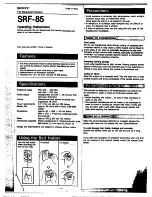
STAGE MONITOR EQUALIZATION
IMPORTANT NOTES:
1. This set-up, using the Rane microphone, provides the most expedient method to optimize stage monitor sound quality
and reduce feedback problems. Feedback induced by specific stage mic/monitor speaker coupling can also be attenuated by
leaving the stage mic turned up and running up the pink noise level through the monitor speaker until feedback occurs.
Attenuate each feedback frequency, as indicated by the analyzer display, until the mic/monitor combination feeds back at
two or more frequencies simultaneously. Usually the final EQ setting will be a compromise between a good monitor sound
that doesn’t get as loud, or a not-so-good monitor sound that gets louder before feedback,
2. The run between the RE 27 and the monitor amp should be balanced whenever possible.
3. Place the Rane microphone at eye level of the performer and about six inches off to one side of the stage microphone,
in line of sight to the monitor speaker. If the stage microphone is directly between the Rane mic and monitor speaker
(blocking line of sight), some high frequencies will be blocked giving a false reading on the analyzer display.
4. If you are running more than one monitor from a single equalizer, test each monitor location by running up pink noise
until feedback occurs. The monitor which feeds back soonest should be used for the overall EQ adjustments using pink noise.
5. If maximum SPL before feedback is most important, use the stage mic only. If your mixer has a send/receive loop for
each input, temporarily patch the send from the stage mic mixer input to the RE 27 EQ INPUT, and patch the PINK NOISE
OUTPUT from the RE 27 to the receive. This arrangement allows the analyzer to look at the specific relationship between
each stage microphone/speaker combination. Since both the microphone and stage monitor speaker exhibit their own
individual feedback tendencies, the interaction between the two can cause pronounced feedback problems. This configura-
tion allows you to flatten or “normalize” this interaction without actually getting to feedback levels. It should be noted that
this testing procedure favors maximum SPL before feedback and not necessarily optimum monitor sound quality. After the
equalizer curve is set, reconnect the system as shown above (without the Pink Noise connection). This configuration can also
be used for main speaker equalization to optimize system response for a specific microphone used throughout the system,
such as for choir, orchestral or big band situations where all program material is picked up through microphones of the same
make and model. After setting the equalizer curve, make the final output connection for the equalizer to the main amp(s) and
speakers instead of the monitor system as shown
6. Do not attempt to plug a regular microphone directly into the RTA MIC INPUT. See RaneNote 104 regarding use of
other microphones with the RE 27.


























